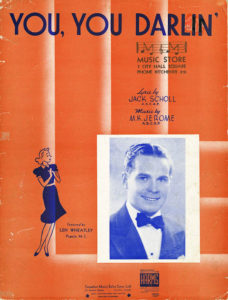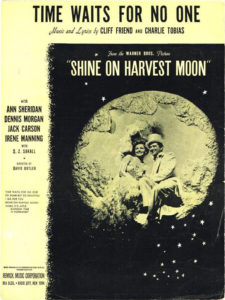
 Here’s one more post about a selection of songs Stalling used for original main title sequences in Warner Bros. cartoons before they were re-issued.
Here’s one more post about a selection of songs Stalling used for original main title sequences in Warner Bros. cartoons before they were re-issued.
In early 1940, Warner Bros. released a short B-feature entitled Tear Gas Squad, starring Dennis Morgan. In the film, he plays piano and sings “You, You Darling” (by M.K. Jerome and Jack Scholl) in the home of Jerry Sullivan (played by Gloria Dickson) and her family. In concurrence with the production of the live-action film, Carl Stalling used the song in Bob Clampett’s Porky’s Poor Fish, as whistled by Porky as he leaves his pet shop for a lunch break. A month before the release of these films, Duke Ellington and His Orchestra recorded “You, You Darlin’” for RCA Victor, sung by his baritone Herb Jeffries.
Stalling used the tune as musical underscore in subsequent cartoons throughout the 1940s (Patient Porky, Who’s Who in the Zoo, Lost and Foundling, and Dough Ray Me-Ow, among them), but only used the song in one main title sequence—Bob Clampett’s Goofy Groceries (1941), one of the rare examples of Clampett’s “Katz unit” outside of their usual black-and-white Looney Tunes. Here is Duke Ellington’s rendition of the song:
 In late 1941, a novelty tune copyrighted as “Tica Ti-Tica Ta,” involved a woman who is given the name by her suitors since her real name is unpronounceable. The song was written and composed by popular trumpeter, singer and bandleader Louis Prima, whose band became popular in nightclubs and records during the 1940s. Various artists such as The Andrews Sisters, Vaughan Monroe, and Dick Todd sang their own covers of “Tica Ti-Tica Ta” on records. The song also warranted a musical “Soundie” short film with the gender roles reversed, featuring Ginger Harmon and the Mercer Brothers.
In late 1941, a novelty tune copyrighted as “Tica Ti-Tica Ta,” involved a woman who is given the name by her suitors since her real name is unpronounceable. The song was written and composed by popular trumpeter, singer and bandleader Louis Prima, whose band became popular in nightclubs and records during the 1940s. Various artists such as The Andrews Sisters, Vaughan Monroe, and Dick Todd sang their own covers of “Tica Ti-Tica Ta” on records. The song also warranted a musical “Soundie” short film with the gender roles reversed, featuring Ginger Harmon and the Mercer Brothers.
Carl Stalling used Prima’s song in a small number of Warners cartoons in 1942, when the song became widely available on records, including Porky’s Café, The Wabbit Who Came to Supper, and Dog Tired. Stalling revived the song in the 1953 Daffy Duck cartoon Muscle Tussle during the “Atomcol” sequence. Stalling’s musical score implanted “Tica Ti-Tica Ta” into the opening titles for only one cartoon—Chuck Jones’ Fox Pop, released in late 1942. Here is Vaughan Monroe’s recording of the song:
Another 1941 song Carl Stalling used in a few Warners cartoons was the relaxed swing tune “Keep Cool Fool,” credited to Josef Myrow and Doc Rhythm. The tune received many renditions from various orchestras and performers throughout 1941, including Ella Fitzgerald, The Ink Spots, Raymond Scott, Erskine Hawkins and Les Brown’s band, with lead vocals by Doris Day.
“Keep Cool Fool” can be heard in the musical underscore on such Warners cartoons as Snow Time for Comedy (1941), Porky’s Café (1942), A Tale of Two Kitties (1942), as well as later appearances underneath the main titles for Art Davis’ Doggone Cats (1947) and Bob McKimson’s Fool Coverage (1952). Scott Bradley, composer for MGM’s cartoons, used it under the opening titles for the Oscar-winning Tom and Jerry cartoon Quiet Please! (1945). As for other Warners cartoons, “Keep Cool Fool” was originally used under the main title sequence in an earlier film, Friz Freleng’s Oscar-nominated Greetings Bait (1943), featuring the Jerry Colonna-esque Wacky Worm, which has only circulated under re-issue prints. Here is Stalling’s rendition of the song under the titles from Doggone Cats, one of the many “Blue Ribbon” re-issues with original title sequences that have been found, decades after.
 Naturally, Carl Stalling lifted songs from recent Warner Bros. features to use in the musical score for their respective cartoons. In the film Shine on Harvest Moon (1944), Ann Sheridan (dubbed by Lynn Martin) sings “Time Waits for No One,” a ballad written by Cliff Friend and Charles Tobias. (Friend co-wrote “The Merry-Go-Round Broke Down”, the theme music for Looney Tunes, with Dave Franklin, and Tobias co-wrote “Merrily We Roll Along,” the theme music for Merrie Melodies, with Murray Mencher and Eddie Cantor.)
Naturally, Carl Stalling lifted songs from recent Warner Bros. features to use in the musical score for their respective cartoons. In the film Shine on Harvest Moon (1944), Ann Sheridan (dubbed by Lynn Martin) sings “Time Waits for No One,” a ballad written by Cliff Friend and Charles Tobias. (Friend co-wrote “The Merry-Go-Round Broke Down”, the theme music for Looney Tunes, with Dave Franklin, and Tobias co-wrote “Merrily We Roll Along,” the theme music for Merrie Melodies, with Murray Mencher and Eddie Cantor.)
Throughout 1944, “Time Waits for No One” garnered several performances by numerous orchestras and singers, with the most successful being Helen Forrest (formerly from Harry James’ band), which landed on the #2 spot on the Billboard charts. Other artists who recorded the song were Johnny Long and His Orchestra (with vocals by Patti Dugan) and Dick Haymes.
Carl Stalling used Friend and Tobias’ song for such cartoons as Odor-Able Kitty (1945), Daffy Doodles (1946), The Gay Anties (1947), and A Pest in the House (1947), among others. “Time Waits for No One” can be heard under the original main titles for Bob McKimson’s Crowing Pains (1947), which have been re-instated for home video release. Evidently, Stalling’s first usage of the song occurred in Chuck Jones’ Lost and Foundling (1944), with Sniffles the Mouse. Here is Johnny Long’s version of “Time Waits for No One.”
I might write more about original main title cues, but for the sake of seeming slightly repetitive, it’s best to dole these types of posts like gems. Next week, I would like to introduce another idea I have had for a while—different animators and directors in one individual profile. The person that will be profiled next week has almost a cult following and deserves a re-evaluation of his career. Keep a sharp lookout!
(Thanks to Daniel Goldmark, Andrew Gilmore and Yowp for their help.)


 DEVON BAXTER is a film restoration artist, video editor, and animation researcher/writer currently residing in Pennsylvania. He also hosts a
DEVON BAXTER is a film restoration artist, video editor, and animation researcher/writer currently residing in Pennsylvania. He also hosts a 





















































































Pretty sure Bradley DIDN’T use “Keep Cool, Fool” in “Quiet Please”, since they didn’t own that tune.
Your mention of singer Herb Jefferies reminded me that he had an acting career as well. He starred as the first singing black cowboy in such films as Harlem on the Prairie, The Bronze Buckaroo, Harlem Rides the Range and Two-Gun Man from Harlem.
I don’t think that the musical underscore for “QUIET, PLEASE” is quite the tune, “BE COOL FOOL”. Certain passages sound similar, but the tune is not exactly the same. Perhaps the TOM AND JERRY cartoon is a Scott Bradley original, but not quite “Be Cool Fool”. Besides, if Warner Brothers had the rights to the melody, wouldn’t it be doubtful that MGM could use it? Could it have fallen into the public domain that fast?
Well, “You Must Have Been a Beautiful Baby” did show up in “Baby Puss” for whatever reason, but they probably paid for the usage of it.
Evan: Are you not thinking of “Baby Face” (which sort of lent its name to the cartoon)? It appeared in “Baby Puss” as well as in Warners cartoons.
Love “You, You Darling”. Its use in “Who’s Who in the Zoo” never fails to put a smile on my face.
“The person that will be profiled next week has almost a cult following and deserves a re-evaluation of his career. ”
Bob Clampett? That’s my best guess.
If it’s a director, I would guess someone like Frank Tashlin or Shamus Culhane. From my impression, both of them are talked about less than Clampett. But they ARE still acclaimed, so who knows.
If it’s an animator… way too many to choose from, and probably way too many I don’t know much about, either. But maybeeee… Jim Tyer?
I’m pretty sure the musical underscore for “Quiet, Please” is “Milkman, Keep Those Bottles Quiet”, though I could be wrong